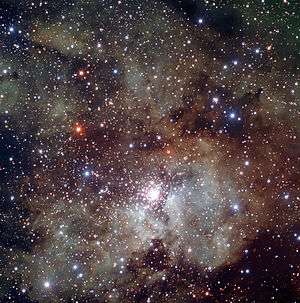WR 42e
| Observation data Epoch J2000.0 Equinox J2000.0 | |
|---|---|
| Constellation | Carina |
| Right ascension | 11h 14m 45.50s[1] |
| Declination | −61° 15′ 00.1″[1] |
| Apparent magnitude (V) | 14.53[2] |
| Characteristics | |
| Spectral type | O2If*/WN6[2] |
| Apparent magnitude (U) | 16.31[2] |
| Apparent magnitude (B) | 16.05[2] |
| Apparent magnitude (V) | 14.53[2] |
| Apparent magnitude (I) | 12.05[2] |
| Apparent magnitude (J) | 10.177[1] |
| Apparent magnitude (H) | 9.466[1] |
| Apparent magnitude (K) | 9.037[1] |
| U−B color index | +0.26[2] |
| B−V color index | +1.52[2] |
| Astrometry | |
| Distance | 25,000 ly (7,600[2] pc) |
| Absolute magnitude (MV) | −6.3[2] |
| Details | |
| Mass | 125-135[3] M☉ |
| Luminosity | 3,200,000[2] L☉ |
| Age | 1-2[2][3] Myr |
| Other designations | |
| Database references | |
| SIMBAD | data |
WR 42e (2MASS J11144550-115001) is a Wolf-Rayet star in the massive H II region NGC 3603 in the constellation of the Carina. It is around 25,000 light years or 7,600 parsec from the Sun. WR 42e is one of the most massive and most luminous stars known.
WR 42e was first catalogued in 2004 as a member of NGC 3603, numbered 954. It was noted as having x-ray and Hα emission.[5] A detailed study published in 2012 showed that the faint red star was actually a highly obscured (6.4 magnitudes in the visual) hot blue Wolf Rayet star and gave it the name WR 42e.[2] Subsequent changes to the naming conventions for new galactic Wolf Rayet stars mean it is also called WR 42-1.[4]
WR 42e is located 2.7 arcmin west-northwest of the massive open cluster HD 97950 at the heart of NGC 3603,[3] corresponding to 6 parsecs at the distance of NGC 3603.[2] This is outside the compact core of the cluster where similar massive luminous stars are found. It is speculated that WR 42e was ejected in an unusual three-body encounter possibly involving the merger of two of the stars and the ejection of both the resulting objects.[3]
See also
References
- 1 2 3 4 5 Cutri, R. M.; Skrutskie, M. F.; van Dyk, S.; Beichman, C. A.; Carpenter, J. M.; Chester, T.; Cambresy, L.; Evans, T.; Fowler, J.; Gizis, J.; Howard, E.; Huchra, J.; Jarrett, T.; Kopan, E. L.; Kirkpatrick, J. D.; Light, R. M.; Marsh, K. A.; McCallon, H.; Schneider, S.; Stiening, R.; Sykes, M.; Weinberg, M.; Wheaton, W. A.; Wheelock, S.; Zacarias, N. (2003). "VizieR Online Data Catalog: 2MASS All-Sky Catalog of Point Sources (Cutri+ 2003)". VizieR On-line Data Catalog: II/246. Originally published in: 2003yCat.2246....0C. 2246. Bibcode:2003yCat.2246....0C.
- 1 2 3 4 5 6 7 8 9 10 11 12 13 14 Roman, A.; Lopes (2012). "A Galactic O2 If*/WN6 star possibly ejected from its birthplace in NGC 3603". Monthly Notices of the Royal Astronomical Society: Letters. 427: L65. arXiv:1209.1598
 . Bibcode:2012MNRAS.427L..65R. doi:10.1111/j.1745-3933.2012.01346.x.
. Bibcode:2012MNRAS.427L..65R. doi:10.1111/j.1745-3933.2012.01346.x. - 1 2 3 4 Gvaramadze, V. V.; Kniazev, A. V.; Chené, A. -N.; Schnurr, O. (2012). "Two massive stars possibly ejected from NGC 3603 via a three-body encounter". arXiv:1211.5926
 . Bibcode:2013MNRAS.430L..20G. doi:10.1093/mnrasl/sls041.
. Bibcode:2013MNRAS.430L..20G. doi:10.1093/mnrasl/sls041. - 1 2 Rosslowe, C. K.; Crowther, P. A. (2014). "Spatial distribution of Galactic Wolf–Rayet stars and implications for the global population". Monthly Notices of the Royal Astronomical Society. 447 (3): 2322. arXiv:1412.0699
 . Bibcode:2015MNRAS.447.2322R. doi:10.1093/mnras/stu2525.
. Bibcode:2015MNRAS.447.2322R. doi:10.1093/mnras/stu2525. - ↑ Sung, H.; Bessell, M. S. (2004). "The Initial Mass Function and Stellar Content of NGC 3603". Astronomy & Astrophysics. 127 (2): 1014. Bibcode:2004AJ....127.1014S. doi:10.1086/381297.
Coordinates: ![]() 11h 14m 42.50s, −61° 15′ 00.1″
11h 14m 42.50s, −61° 15′ 00.1″
